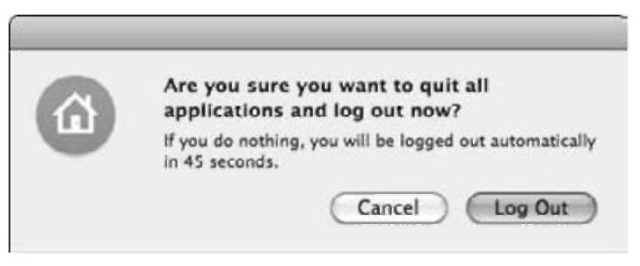Take a look at the changes you can make to the login process. First, Mac OS X provides two methods of displaying the login screen, as well as one automatic method that doesn’t display the login screen at all:
♦ Logging in with a list: To log in, click your account username in the list, and the login screen displays the password prompt. Type your password — Mac OS X displays bullet characters to ensure security — and press Return (or click the Log In button).
♦ Logging in with username and password: Type your account username in the Name field and press Tab. Then type your password and press Return (or click the Log In button).
♦ Automatic Login: With Automatic Login set, Mac OS X automatically logs in the specified account when you reboot. In effect, you never see the login screen unless you click Log Out from the Apple menu. (Naturally, this is an attractive option to use if your computer is in a secure location — such as your office — and you’ll be the only one using your MacBook. However, if your laptop falls into The Wrong Hands, you’re inviting trouble . . . and identity theft.)
To specify which type of login screen you see — if you see one at all — head to System Preferences, click Accounts, and then click the Login Options button. (If the pane is locked, click the Lock icon and supply your admin password.)
♦ To set Automatic Login, display the Login Options settings and click the Automatic Login pop-up menu. Choose the account that automatically logs in from the list. When Mac OS X displays the user Name and Password sheet that you see in Figure 4-1, type the corresponding password and then click OK.

Figure 4-1:Configuring Automatic Login from the Accounts pane.
Never set the Automatic Login feature to an admin-level account unless you’re sure to be the only one using your MacBook. If the
computer is rebooted, you’re opening the door for anyone to simply sashay in and wreak havoc!
♦ To determine whether Mac OS X uses a list login screen, you must again visit the Login Options settings pane (see Figure 4-2). Select the List of Users radio button for a list login screen or select the Name and Password radio button for a simple login screen where you must type your username and password.
To change settings specific to your account — no matter what your access level — log in with your account, open System Preferences, and click Accounts. From here, you can change your account password and picture, the card marked as yours within the Address topic, and the Login Items launched automatically when you log in. (Peruse more information on the Address topic in topic I, topic 6.)
To log out of Mac OS X without restarting or shutting down the computer, choose the Apple menu and then choose Log Out or just press 96+Shift+Q. You see the confirmation dialog, as shown in Figure 4-3. Although Mac OS X will display the login screen after two minutes, someone can still saunter up

and click the Cancel button, thereby gaining access to your stuff. Therefore, make it a practice to always click the Log Out button on this screen before your hand leaves the mouse, or bypass the confirmation dialog altogether by holding down the Option key as you click Log Out from the menu!

Figure 4-2:
Will that be a simple or a list login screen?

Figure 4-3:
Always click Log Out before you leave your MacBook!
You can also enable Fast User Switching from the Login Options pane. This feature allows another user to sit down and log in while the previous user’s applications are still running in the background. When you enable switching, Snow Leopard displays the currently active user’s full name or account icon at the right side of the Finder menu bar. Click the name, and a menu appears; click Login Window, and another user can then log in as usual. (From the Login Options pane, you can also choose to display the current user by the account’s short name or the account icon.)
Even though you’re playing musical chairs, the Big X remembers what’s running and the state of your Desktop when you last left it. (When you decide to switch back, Snow Leopard prompts you for that account’s login password for security . . . just in case, you understand.)
Configuring Your Login Screen (MacBook)
Next post: How Multiuser Works on Mac OS X
Previous post: Locking Things Down (MacBook)
